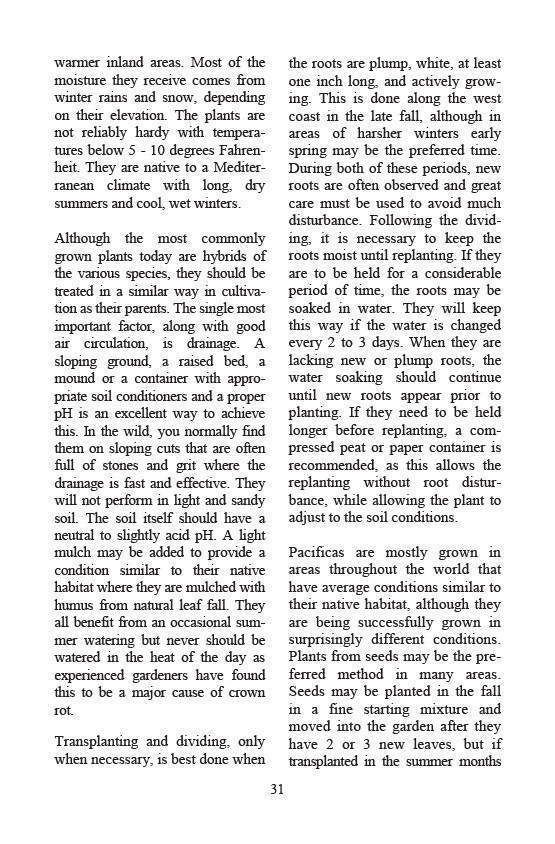
31
warmer inland areas. Most of the
moisture they receive comes from
winter rains and snow, depending
on their elevation. The plants are
not reliably hardy with tempera-tures
below 5 - 10 degrees Fahren-heit.
They are native to a Mediter-ranean
climate with long, dry
summers and cool, wet winters.
Although the most commonly
grown plants today are hybrids of
the various species, they should be
treated in a similar way in cultiva-tion
as their parents. The single most
important factor, along with good
air circulation, is drainage. A
sloping ground, a raised bed, a
mound or a container with appro-priate
soil conditioners and a proper
pH is an excellent way to achieve
this. In the wild, you normally find
them on sloping cuts that are often
full of stones and grit where the
drainage is fast and effective. They
will not perform in light and sandy
soil. The soil itself should have a
neutral to slightly acid pH. A light
mulch may be added to provide a
condition similar to their native
habitat where they are mulched with
humus from natural leaf fall. They
all benefit from an occasional sum-mer
watering but never should be
watered in the heat of the day as
experienced gardeners have found
this to be a major cause of crown
rot.
Transplanting and dividing, only
when necessary, is best done when
the roots are plump, white, at least
one inch long, and actively grow-ing.
This is done along the west
coast in the late fall, although in
areas of harsher winters early
spring may be the preferred time.
During both of these periods, new
roots are often observed and great
care must be used to avoid much
disturbance. Following the divid-ing,
it is necessary to keep the
roots moist until replanting. If they
are to be held for a considerable
period of time, the roots may be
soaked in water. They will keep
this way if the water is changed
every 2 to 3 days. When they are
lacking new or plump roots, the
water soaking should continue
until new roots appear prior to
planting. If they need to be held
longer before replanting, a com-pressed
peat or paper container is
recommended, as this allows the
replanting without root distur-bance,
while allowing the plant to
adjust to the soil conditions.
Pacificas are mostly grown in
areas throughout the world that
have average conditions similar to
their native habitat, although they
are being successfully grown in
surprisingly different conditions.
Plants from seeds may be the pre-ferred
method in many areas.
Seeds may be planted in the fall
in a fine starting mixture and
moved into the garden after they
have 2 or 3 new leaves, but if
transplanted in the summer months